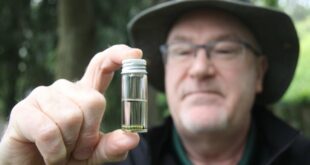Conservation activist calls for standardized labels explaining where plants are grown and sourced.
As the weather warms and spring flowers start to bloom, it’ll soon be prime season to head to a garden centre to get new plants for your space.
Increasing efforts to preserve biodiversity and minimize the impacts of climate change are pushing many horticulture enthusiasts to grow native plant species in their yards.
But according to conservation activist Brendon Samuels, not all plants are labelled accurately.
Some retailers in Ontario sell plants labelled as “native species,” even though they’re not being grown in the province, said Samuels, a biology PhD candidate at Western University in London, Ont.
“We are in the middle of a biodiversity crisis, so we’re at risk of losing a huge number of species within our lifetime due to a variety of factors, including habitat loss.
“People who are aware and want to plant native species are finding it difficult to know if the plants they’re putting into the ground are actually part of local biodiversity, or if they’re introducing foreign genetic material brought in from the U.S.”
Samuels is calling for provincewide regulations that would require plants to have standardized labels telling customers where seeds are sourced from, whether they’ve been imported from elsewhere and if they are invasive species.

Conservation advocate Brendon Samuels joins London Morning with a warning to gardeners that not all plants are as advertised. Samuels is calling for more regulations for labeling native plant species.
“It’s difficult for people to determine at points of sale if this was actually grown and sourced in Ontario, or if it was imported from the U.S., where there’s greater production capacity and similar species,” he said.
‘There’s trust in the label’
Will Heeman, owner of Heeman’s Greenhouse in London believes plants get mislabelled because suppliers ship to a variety of different regions in Ontario. So, although a plant might be native to one part of the province, it may not apply to other areas.
“There’s trust in the label, but we do a second layer of due diligence when sourcing plants because people often tell us ‘We Googled it and thought it was native, so we put it on the tag.’ Whether it’s native to us or not, they might do parts of their sales to areas where it is.”
This puts the onus on retailers and consumers to ensure they are planting something sourced as native to Ontario, Heeman said.
“Having proper signage on things to be able to communicate the benefits and features is always going to be helpful to people,” Heeman said, adding his greenhouse tries to make it simpler for people in lieu of standardized label expectations.
Planting native species is important for Canada to meet its biodiversity targets, Samuels added.
In 2021, the federal government increased its nature protection ambition to address the crises of biodiversity loss and climate change. Their target is to protect 25 per cent of lands and oceans by 2025, with the goal of 30 per cent by 2030.
A lot of Heeman’s clients don’t specifically ask about where seeds are coming from, but his goal is to make native plants more accessible and compelling because of the environmental need for them, he said.
How can you be better informed?
Samuels recommends that gardeners do their own research before heading to a greenhouse and not just rely on what’s said on plants tags. Some resources that can help are:
- USDA Plants Database — where the public can look up species of plants and view maps showing where the species are native and introduced
- Grow Me Instead guides for selecting species that are appropriate for planting in Southern or Northern Ontario
- The 2022 Auditor General of Ontario report on management of invasive species
To make an informed buying decision, Samuels also suggests asking staff at garden centres to explain where plants are grown and sourced.
ABOUT THE AUTHOR

Reporter
Isha Bhargava is a multiplatform reporter for CBC News. She’s worked for Ontario newsrooms in Toronto and London. She loves telling current affairs and human interest stories. You can reach her at isha.bhargava@cbc.ca
*****
Credit belongs to : www.cbc.ca
 Atin Ito First Filipino Community Newspaper in Ontario
Atin Ito First Filipino Community Newspaper in Ontario






